back to the list of in-depth studies
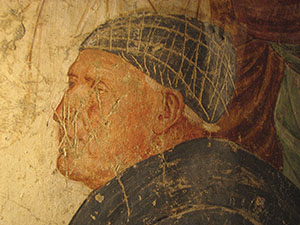
Graffiti and vandalism of the frescos of the Tabernacle of the Madonna of the Cough, Castelfiorentino.
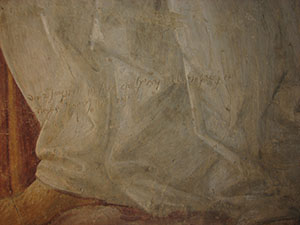
Inscription on an angel’s robe on the back wall of the Tabernacle of the Madonna of the Cough.
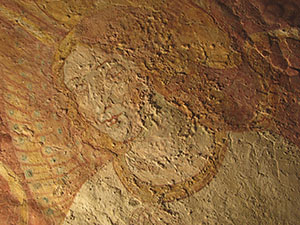
Salt deposits inside the paint and plaster of the Tabernacle of the Madonna of the Cough.
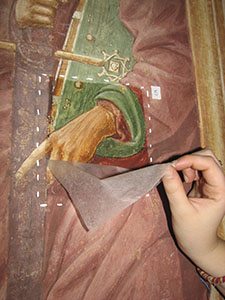
Final cleaning of the frescos through application of Japanese paper soaked in an aqueous solution of ammonium bicarbonate.
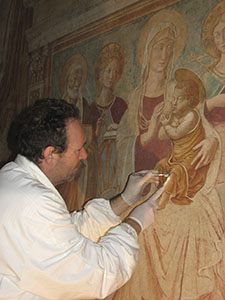
Final cleaning of the frescos with cotton balls soaked in demineralised water.
The Tabernacle of the Madonna of the Cough, at the foot of Castelnuovo Castle, near the junction between the flat road and the steeper one the castle’s ancient inhabitants had to use to get to the old mill located on the left bank of the Elsa river, was decorated by Benozzo Gozzoli in 1484. Architecturally, the tabernacle was built in the form of a chapel, enclosed on three sides and with a cross-vaulted ceiling and gabled roof, reaching a height of 4.50 m. Horizontally, it is 3.50 m deep while the width of the altar wall is 3.35 m and that of the entrance wall is 3.85 m. The greater width of the entrance wall than the back wall, created through the fanning of the side walls, must have served to create a scenic perspective effect for those descending from the castle.
Very early on, in order to save the frescoes from graffiti and vandalism, an enclosing wall was built across the entrance, with a door and two windows at the sides. The construction of this wall, against the two pilasters at the sides and the archivolt, must have ruined some of the existing frescoes and inscriptions.
In 1853, the said enclosing wall was removed, and the engineer Giovanni Battista Petrioli built the neo-Gothic-style wall face which can still be seen today. This wall structure was set slightly forward of the original entrance archivolt, making it possible to fully uncover the remaining decorations once again.
During that same year, as noted by G. Tosi, the altar was removed. This altar was probably not original, since it can be observed from the remaining fresco fragments that Benozzo Gozzoli painted a trompe l’oeil altarpiece, complete with all the carpentry, on the end wall accompanied by the panel depicting the Madonna feeding the Child with Saints in the upper section.
Removal of the stone altar revealed the artist’s signature, "MA...F...M.. Beno florentinus depi", as transcribed by G. Carocci in 1894. Through careful examination, it can now be read as: "MAIA E.. M.. BENOZ. FIORENT..O.DIPIS…".
The frescoes were removed from the wall in 1970 by the Tintori, Rosi and Del Serra studio through application of two cloths with hot animal glue. The new backing for the painted surface was made from two calico cloths with a vinyl-based adhesive and calcium carbonate. The cloths used to detach the frescoes were subsequently removed using hot water and steam. The frescoes were then applied to 0.4 cm-thick fibreglass and flame retardant epoxy resin backings.
The numerous instances of vandalism of the frescoes (such as inscriptions, abrasions, etc.) by passers-by and visitors - some of which took place in ancient times and are now of "historic interest" - should be noted. Of particular interest is the following early Italian inscription on the robe of an angel on the back wall: "Roberto Pucci was ordained Cardinal on 2 nd June 1542 and died on 16 th [sic] January 1546") ("Die 2 junii 1542 fu fatto cardinali Ruberto Pucci et die XVI [sic!] januarii 1546 obiit").
The entire chapel has now been relocated to the new Museum with its architecture restored to its original size and its corbels reconstructed using mouldings. The marble plaque originally affixed to the chapel’s façade, bearing the name of the work’s commissioner, was also transferred to the museum and replaced in loco by a copy.
The frescoes then underwent a programme of analysis and restoration.
The paintings appeared to be covered by a thin, white glaze and the painted surface was raised in places. The chemical analysis carried out in order to determine the presence of soluble salts revealed a significant sulphate content, attributable not only to the surface deposits but probably also to the penetration of saline deposits into the paint and plasterwork themselves. Chlorides and nitrates were found to be present only in small traces which are not relevant to the work’s state of repair.
All the gildings have been almost entirely lost over time, as have the parts painted "dry", leaving the preparatory drawings visible.
The restoration work was carried out in stages.
The first of these involved removing the solid particles and dust deposits using soft bristle brushes, followed by gentle cleaning with Wischab sponges.
The small areas of raised colour were consolidated through microinjections of acrylic resin (Acril 33/a) in aqueous solution, and some detachments from the backing were consolidated using aqueous solution charged with micronised calcium carbonate.
Since the behaviour of the original materials, and particularly the detached wall paintings, was not always homogenous, it was deemed preferable to proceed little by little, checking the differing levels of cleaning achieved.
Final cleaning was performed by applying Japanese paper soaked in an aqueous solution of 3% ammonium bicarbonate for a contact time of 4 minutes, after which the painted surface was cleaned using cotton balls soaked in demineralised water.
The screws and panel sections were filled in using an acrylic-based mortar charged with inert substances (sand, pumice, tuff and calcium carbonate), of various grains and pigmentations.
Finally, the frescoes were treated with a multi-purpose biocide (Biotin N diluted to 1.5% in water) to protect them from future attacks by biological agents.
The last stage involved restoration of the painted images using watercolour paints. In order to achieve a critical restoration of the pictorial text, the chromatic selection method was used to fill in the gaps and missing parts, with tone-lowering in all the areas of abrasion, damage or loss of the painted layer.
Fabrizio Iacopini